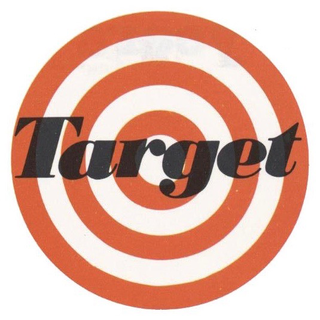
Walgreen Company, d/b/a Walgreens, is an American company that operates the second-largest pharmacy store chain in the United States behind CVS Health. It specializes in filling prescriptions, health and wellness products, health information, and photo services. It was founded in Chicago, Illinois, in 1901, and is headquartered in the Chicago suburb of Deerfield, Illinois. On December 31, 2014, Walgreens and Switzerland-based Alliance Boots merged to form a new holding company, Walgreens Boots Alliance Inc. Walgreens became a subsidiary of the new company, which retained its Deerfield headquarters and trades on the Nasdaq under the symbol WBA The company was found by a federal jury to have "substantially contributed to" the opioid crisis.
A discount store or discounter offers a retail format in which products are sold at prices that are in principle lower than an actual or supposed "full retail price". Discounters rely on bulk purchasing and efficient distribution to keep down costs.

OfficeMax is an American office supplies retailer founded in 1988. It is now a subsidiary of The ODP Corporation, which is headquartered in Boca Raton, Florida. As of December 2012, OfficeMax operated 941 stores in 47 states, Puerto Rico, the U.S. Virgin Islands and Mexico. In 2012, net sales were $6.9 billion, down from $8.3 billion in 2008.
Venture Stores, Inc. was a chain of retail stores aimed at the discount department-store market. John Geisse, formerly of Target Stores, and May Department Stores' executive vice president, Dave Babcock, founded the chain in 1968. Venture Stores expanded to operate over 70 stores with major market share in St. Louis, Chicago, and Kansas City, and expanded across various areas in the United States over a period of nearly 30 years, becoming the largest discount chain in Chicago. In January 1998, Venture Stores entered a Chapter 11 bankruptcy and closed within six months.

Dillard's, Inc. is an upscale American department store chain with approximately 282 stores in 29 states and headquartered in Little Rock, Arkansas. Currently, the largest number of stores are located in Texas with 57 and Florida with 42. The company also has stores in 27 more states; however, it is absent from the Northeast, most of the Upper Midwest, the Northwest, and most of California, aside from three stores in smaller cities.

Kmart Australia Limited is an Australian chain of department stores owned by the Kmart Group division of Wesfarmers. The company operates 323 stores across Australia and New Zealand, with its head office located in Mulgrave, Melbourne. Kmart Group, the department store division of Wesfarmers, also owns and operates Target Australia and online retailer Catch.com.au.

Giant Tiger Stores Limited is a Canadian discount store chain which operates over 260 stores across Canada. The company's stores operate under the Giant Tiger banner in Alberta, Manitoba, New Brunswick, Nova Scotia, Ontario, Prince Edward Island and Saskatchewan; under the GTExpress and Scott's Discount banners in Ontario only, and under the Tigre Géant banner in Quebec.

Rite Aid Corporation is an American drugstore chain based in Philadelphia, Pennsylvania. It was founded in 1962 in Scranton, Pennsylvania, by Alex Grass under the name Thrift D Discount Center. The company ranked No. 148 in the Fortune 500 list of the largest United States corporations by total revenue.

A big-box store is a physically large retail establishment, usually part of a chain of stores. The term sometimes also refers, by extension, to the company that operates the store.
Miracle Mart was a chain of discount department stores with locations in Ontario and Quebec, Canada based in Saint-Laurent, Quebec. The chain was renamed to simply M in the mid-1980s.
No Frills is a Canadian chain of discount supermarkets, owned by Loblaw Companies Limited, a subsidiary of George Weston Limited. There are over 200 franchise stores located in nine Canadian provinces.

BIG W is an Australian chain of discount department stores, which was founded in regional New South Wales in 1964. The company is a division of Woolworths Group and as at 2019 operated 176 stores, with around 22,000 employees mainly in Australia. BIG W stocks clothing, health and beauty, garden, pet items, books, DVDs, CDs, some furniture items, snack food and small electrical household appliances.

Lechmere ( "leech-meer") was a Massachusetts-based chain of retail stores that closed in 1997. At the time of its closing, it had 27 stores, including 20 in New England. The chain offered electronics, appliances, and various household goods. It also had locations in New York and the Southeastern United States.
Thrifty PayLess Holdings, Inc. was a pharmacy holding company that owned the Thrifty Drugs and PayLess Drug Stores chains in the western United States. The combined company was formed in April 1994 when Los Angeles-based TCH Corporation, the parent company of Thrifty Corporation and Thrifty Drug Stores, Inc., acquired the Kmart subsidiary PayLess Drug Stores Northwest, Inc. At the time of the merger, TCH Corporation was renamed Thrifty PayLess Holdings, Inc. and Thrifty operated 495 stores, PayLess operated 543 stores.

Drug Emporium is the name of a discount drug store corporation, founded in 1977 in Columbus, Ohio, that was sold to several different buyers during 2000 to 2001. Although several store locations continue to use the Drug Emporium name, these locations are no longer affiliated with the now-defunct Columbus-based corporation. At the company's high water mark in the 1990s, there were almost 300 locations scattered throughout the United States, including stores that operated under the F&M and VIX banners.

FedMart was a chain of discount department stores started by Sol Price, who later founded Price Club. His first location in San Diego, California was in a converted airport hangar where planes were parked for fun. Originally a discount department store open to government employees paying a $2 per family membership fee, FedMart's first year was highly successful to some, yet struggled to others. Over the next 20 years FedMart grew to include 45 stores, mostly in California and the Southwest, in a chain that generated over $300 million in annual sales. The business expanded to several states in the Southwest United States. Many stores were previous White Front or Two Guys locations. Price later sold two-thirds of the chain to Hugo Mann, a German retail chain, in 1975 and was forced out of his leadership position the following year. FedMart went out of business in 1982.
Interstate Department Stores, Inc., was an American holding company for a chain of small department stores, founded in Delaware in 1928. After a very rapid expansion as the result of acquisition and expansion of two discount store chains acquired in 1959 and 1960 and also two toy store chains acquired in 1967 and 1969, the firm was renamed in 1970 as Interstate Stores, Inc., to better reflect its business. Increased competition and the changes in consumer buying habits eventually led to decreased sales in the late 1960s and early 1970s which forced the firm to file for bankruptcy in 1974. After shedding all of its non-performing units, the firm was able to exit bankruptcy with the entire toy division intact along with a small remnant of the department store division in 1978. The firm was renamed Toys "R" Us upon emergence from bankruptcy.

The history of Target Corporation first began in 1902 by George Dayton. The company was originally named Goodfellow Dry Goods in June 1902 before being renamed the Dayton's Dry Goods Company in 1903 and later the Dayton Company in 1910. The first Target store opened in Roseville, Minnesota in 1962 while the parent company was renamed the Dayton Corporation in 1967. It became the Dayton-Hudson Corporation after merging with the J.L. Hudson Company in 1969 and held ownership of several department store chains including Dayton's, Hudson's, Marshall Field's, and Mervyn's. In 2000, the Dayton-Hudson Corporation was renamed to Target Corporation.
Horizon was a Canadian discount department retailer founded in 1972 by T. Eaton Co. Limited. Attempting to compete with established Canadian brands like Woolco and Zellers during a downturn in the market, it was T. Eaton's attempt to court "buyers", as opposed to the "shoppers" courted at its Eaton's stores. Instead, the chain was generally unprofitable, cannibalizing sales from its sister Eaton's stores, and misplaced, according to analysts. Intended to be a 122-store chain, it only reached 18 locations before closing in 1979, less than seven years after opening. The financial drag of the chain in the 1970s is said to have contributed to T. Eaton's significant financial problems in the 1980s.












